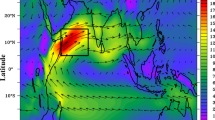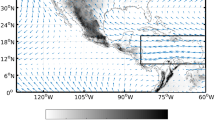Abstract
A maximum of easterly zonal wind at 925 hPa in the Caribbean region is called the Caribbean Low-Level Jet (CLLJ). Observations show that the easterly CLLJ varies semi-annually, with two maxima in the summer and winter and two minima in the fall and spring. Associated with the summertime strong CLLJ are a maximum of sea level pressure (SLP), a relative minimum of rainfall (the mid-summer drought), and a minimum of tropical cyclogenesis in July in the Caribbean Sea. It is found that both the meridional gradients of sea surface temperature (SST) and SLP show a semi-annual feature, consistent with the semi-annual variation of the CLLJ. The CLLJ anomalies vary with the Caribbean SLP anomalies that are connected to the variation of the North Atlantic Subtropical High (NASH). In association with the cold (warm) Caribbean SST anomalies, the atmosphere shows the high (low) SLP anomalies near the Caribbean region that are consistent with the anomalously strong (weak) easterly CLLJ. The CLLJ is also remotely related to the SST anomalies in the Pacific and Atlantic, reflecting that these SST variations affect the NASH. During the winter, warm (cold) SST anomalies in the tropical Pacific correspond to a weak (strong) easterly CLLJ. However, this relationship is reversed during the summer. This is because the effects of ENSO on the NASH are opposite during the winter and summer. The CLLJ varies in phase with the North Atlantic Oscillation (NAO) since a strong (weak) NASH is associated with a strengthening (weakening) of both the CLLJ and the NAO. The CLLJ is positively correlated with the 925-hPa meridional wind anomalies from the ocean to the United States via the Gulf of Mexico. Thus, the CLLJ and the meridional wind carry moisture from the ocean to the central United States, usually resulting in an opposite (or dipole) rainfall pattern in the tropical North Atlantic Ocean and Atlantic warm pool versus the central United States.













Similar content being viewed by others
References
Adler RF, et al (2003) The version-2 global precipitation climatology project (GPCP) monthly precipitation analysis (1979-present). J Hydrometeorol 4:1147–1167
Amador JA (1998) A climatic feature of the tropical Americas: The trade wind easterly jet. Top Meteor Oceanogr 5(2):1–13
Amador JA, Magana V (1999) Dynamics of the low level jet over the Caribbean Sea. Preprints, the 23rd conference on hurricanes and tropical meteorology, American Meteorological Society, Dallas, pp 868–869
Bosilovich MG, Schubert SD (2002) Water vapor tracers as diagnostics of the regional hydrologic cycle. J Hydrometeorol 3:149–165
Brubaker KL, Dirmeyer PA, Sudradjat A, Levy B, Bernal F (2001) A 36-yr climatological description of the evaporative sources of warm season precipitation in the Mississippi river basin. J Hydrometeorol 2:537–557
Emery WJ, Thomson RE (1997) Data analysis methods in physical oceanography. Elsevier, Amsterdam, p 638
Enfield DB, Mayer DA (1997) Tropical Atlantic sea surface temperature variability and its relation to El Niño-Southern Oscillation. J Geophys Res 102:929–945
Gill AE (1980) Some simple solutions for heat-induced tropical circulation. Q J R Meteorol Soc 106:447–462
Gray WM (1984) Atlantic seasonal hurricanes frequency. Part II: forecasting its variability. M Weather Rev 112:1669–1683
Hu Q, Feng S (2001) Climate role of the southerly flow from the Gulf of Mexico in interannual variations in summer rainfall in the Central United States. J Clim 14:3156–3170
Hurrel JM (1995) Decadal trends in the North Atlantic Oscillation: regional temperature and precipitation. Science 269:676–679
Inoue M, Handoh IC, Bigg GR (2002) Bimodal distribution of tropical cyclogenesis in the Caribbean: characteristics and environmental factors. J Clim 15:2897–2905
Kalnay E, et al (1996) The NCEP/NCAR 40-year reanalysis project. Bull Am Meteorol Soc 77:437–471
Lindzen RS, Nigam S (1987) On the role of sea surface temperature gradients in forcing low-level winds and convergence in the Tropics. J Atmos Sci 44:2418–2436
Magaña V, Amador JA, Medina S (1999) The midsummer drought over Mexico and central America. J. Clim 12:1577–1588
Mapes BE, Liu P, Buenning N (2005) Indian monsoon onset and the Americas midsummer drought: out-of-equilibrium response to smooth seasonal forcing. J Clim 18:1109–1115
Mestas-Nunez AM, Zhang C, Enfield DB (2005) Uncertainties in estimating moisture fluxes over the Intra-Americas Sea. J Hydrometeorol 6:696–709
Mo KC, Higgins RW (1996) Large-scale atmospheric water vapor transport as evaluated from the NCEP/NCAR and the NASA/DOA reanalyses. J Clim 9:1531–1545
Mo KC, Chelliah M, Carrera ML, Higgins RW, Ebisuzaki W (2005) Atmospheric moisture transport over the United States and Mexico as evaluated in the NCEP regional reanalysis. J Hydrometeorol 6:710–728
Poveda G, Mesa OJ (1999) The low level westerly jet (Choco jet) and two other jets in Colombia: climatology and variability during ENSO phases (in Spanish). Rev Academia Colomb Cienc 23(89):517–528
Poveda G, Waylen PR, Pulwarty RS (2006) Annual and interannual variability of the present climate in northern South America and southern Mesoamerica. Palaeogeogr Palaeoclimatol Palaeoecol 234:3–27
Rasmusson EM (1967) Atmospheric water vapor transport and the water balance of North America: part I. Characteristics of the water vapor flux field. M Weather Rev 95:403–426
Shay LK, Goni GJ, Black PG (2000) Effects of a warm oceanic feature on Hurricane Opal. M Wea Rev 128:1366–1383
Smith TM, Reynolds RW (2004) Improved extended reconstruction of SST (1854–1997). J Clim 17:2466–2477
Wang C, Enfield DB (2001) The tropical Western Hemisphere warm pool. Geophys Res Lett 28:1635–1638
Wang C, Enfield DB (2003) A further study of the tropical Western Hemisphere warm pool. J Clim 16:1476–1493
Wang C, Lee SK (2007) Atlantic warm pool, Caribbean low-level jet and their potential impact on Atlantic hurricanes. Geophys Res Lett 34:L02703. doi:10.1029/2006GL028579
Wang C, Enfield DB, Lee SK, Landsea CW (2006) Influences of the Atlantic warm pool on Western Hemisphere summer rainfall and Atlantic hurricanes. J Clim 19:3011–3028
Wang C, Lee SK, Enfield DB (2007) Impact of the Atlantic warm pool on the summer climate of the Western Hemisphere. J Clim 20 (in press)
Xie P, Arkin PA (1997) Global precipitation: a 17-year monthly analysis based on gauge observations, satellite estimates, and numerical model outputs. Bull Am Meteorol Soc 78:2539–2558
Acknowledgments
I thank Mr Jay Harris for downloading the data used in this study. Dr Sang-ki Lee assists with Fig. 1 and calculates the significance test of the semi-annual feature of the CLLJ. Comments by Dr German Poveda, an anonymous reviewer, and the Editor (Dr Edwin Schneider) are appreciated. This work was supported by a grant from National Oceanic and Atmospheric Administration (NOAA) Climate Program Office and by the base funding of NOAA Atlantic Oceanographic and Meteorological Laboratory. The findings and conclusions in this report are those of the author(s) and do not necessarily represent the views of the funding agency.
Author information
Authors and Affiliations
Corresponding author
Rights and permissions
About this article
Cite this article
Wang, C. Variability of the Caribbean Low-Level Jet and its relations to climate. Clim Dyn 29, 411–422 (2007). https://doi.org/10.1007/s00382-007-0243-z
Received:
Accepted:
Published:
Issue Date:
DOI: https://doi.org/10.1007/s00382-007-0243-z




